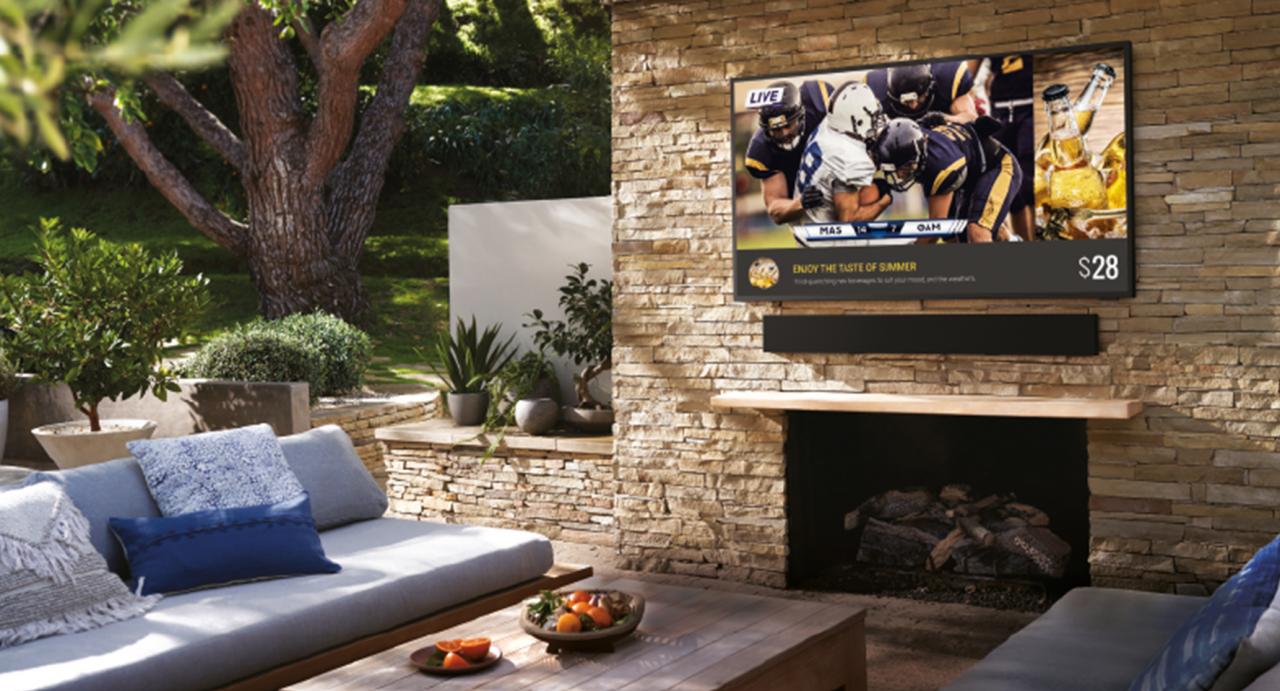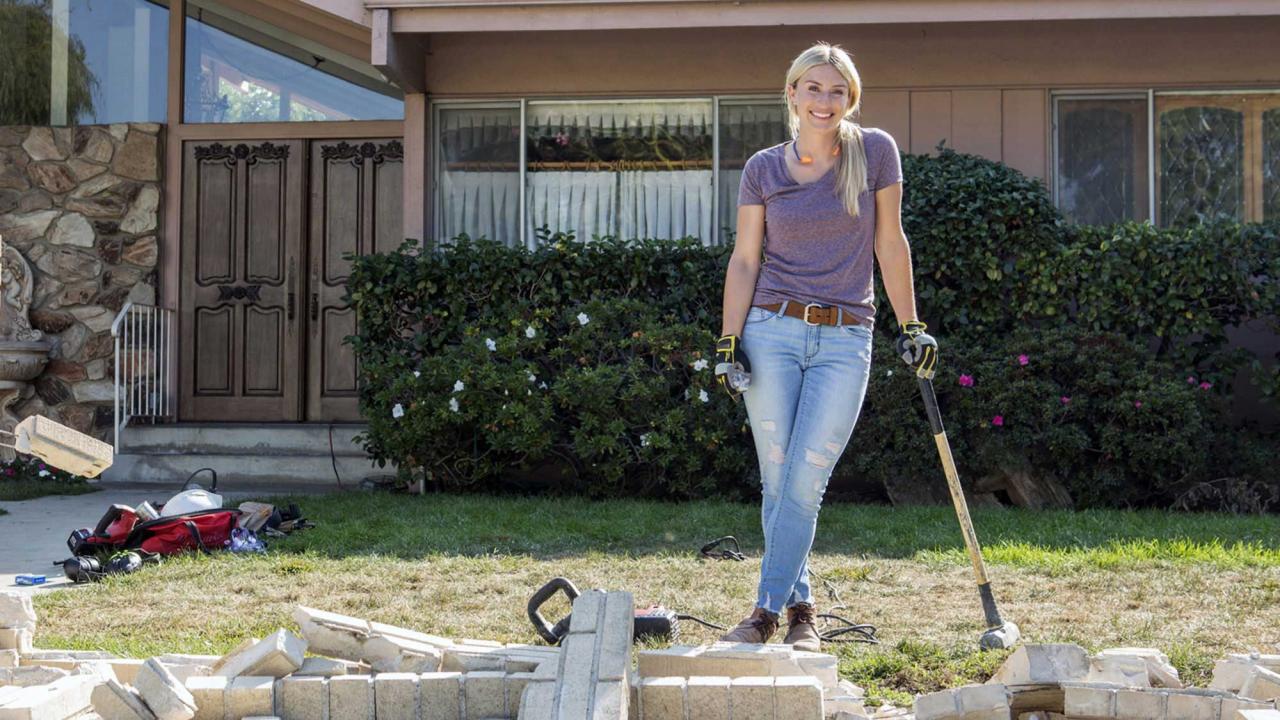Home and Garden TV has exploded onto our screens, transforming how we approach home improvement and gardening. From breathtaking renovations to innovative gardening hacks, these shows offer a captivating blend of inspiration and practical advice. But beyond the stunning visuals and expert advice, there’s a deeper story to explore: the impact on design trends, the power of social media engagement, and the clever strategies behind brand partnerships.
This exploration delves into the various formats of home and garden TV shows, analyzing their target audiences and production styles. We’ll uncover the recurring themes that resonate with viewers, examine the influence of these programs on current home improvement trends, and investigate the crucial role of social media and visual storytelling in their success. Finally, we’ll unpack the world of brand partnerships and how they contribute to the overall viewing experience.
Home and Garden TV Show Formats

Home and garden television shows cater to a diverse audience passionate about improving their living spaces, both indoors and out. The genre encompasses a wide variety of formats, each with its own unique style, target audience, and production approach. From the meticulous artistry of landscape design to the satisfying crunch of a perfectly renovated kitchen, these shows offer viewers inspiration, practical advice, and a healthy dose of escapism.
Different Home and Garden TV Show Formats and Target Audiences
The success of a home and garden show hinges on understanding its target audience. Different formats attract specific demographics with varying interests and skill levels. Below is a table outlining some popular formats and their respective audiences.
| Show Name (Example) | Genre | Description | Target Audience |
|---|---|---|---|
| Love It or List It | Renovation/Real Estate | Couples weigh the pros and cons of renovating their current home versus buying a new one. | Homeowners considering renovation or relocation, particularly those facing challenges with their existing space. |
| Gardening Australia | Gardening | Features various gardening experts offering advice and demonstrations on different gardening techniques and plant care. | Experienced and novice gardeners, individuals interested in sustainable living and growing their own food. |
| The Great British Baking Show (with a garden-themed episode focus) | Cooking (with garden-related content) | While primarily a baking competition, episodes often incorporate homegrown ingredients, showcasing the connection between garden and kitchen. | Baking enthusiasts, individuals interested in seasonal cooking and using fresh, locally sourced ingredients. |
| Property Brothers | Design/Renovation | Twin brothers help clients find and renovate their dream homes, focusing on design and budget management. | Homebuyers, individuals interested in interior design and home renovation projects, those seeking inspiration for their own projects. |
Production Styles of Home and Garden TV Shows
The production style significantly impacts the viewer experience. Comparing shows like Love It or List It, Gardening Australia, and Property Brothers reveals diverse approaches. Love It or List It relies heavily on dramatic tension, contrasting the before-and-after transformations and highlighting the emotional investment of the homeowners. The editing emphasizes conflict and resolution, creating a compelling narrative arc. In contrast, Gardening Australia adopts a more educational and informative tone.
The production is less dramatic, focusing on clear demonstrations and expert advice. The visuals emphasize the beauty of nature and the process of plant growth. Property Brothers balances both elements, combining the excitement of a renovation with the practical aspects of design and budget management. The show employs fast-paced editing, showcasing the transformation process while maintaining a lighthearted and engaging atmosphere.
These varied production styles cater to different viewer preferences and reflect the unique nature of each show’s format and content.
Popular Home and Garden TV Show Themes

Home and garden TV shows have consistently captivated audiences with their blend of practical advice, aspirational lifestyles, and engaging personalities. Several recurring themes contribute to their enduring popularity, reflecting viewers’ desires for improvement, creativity, and connection with the natural world.The success of these shows hinges on their ability to tap into universal human needs and aspirations, offering viewers a glimpse into achievable transformations and inspiring them to create their own havens.
By focusing on relatable challenges and achievable solutions, these programs provide a valuable resource and a source of entertainment.
Home Renovation and Makeovers
This theme dominates the home and garden TV landscape. Shows like “Fixer Upper” and “Love It or List It” showcase dramatic transformations of dilapidated or outdated homes into stunning living spaces. Their popularity stems from the vicarious thrill of witnessing a complete metamorphosis, coupled with the practical advice offered on budgeting, design choices, and the renovation process itself. Viewers are drawn to the before-and-after reveals, feeling inspired to tackle their own home improvement projects, no matter how small.
The relatable struggles and triumphs of homeowners featured further enhance the emotional connection and engagement.
Landscaping and Outdoor Living
The appeal of transforming outdoor spaces is undeniable. Shows focusing on landscaping, gardening, and creating outdoor living areas, such as “Yard Crashers” and various gardening programs, consistently attract large audiences. This theme resonates with viewers’ desire for creating relaxing and aesthetically pleasing outdoor environments. The focus on creating functional and beautiful gardens, patios, and other outdoor features speaks to a growing interest in sustainable living, enhancing property value, and enjoying the benefits of nature.
The aspirational element of showcasing luxurious outdoor retreats further fuels the popularity of this theme.
Home and Garden TV offers a wealth of inspiration for sprucing up your living space, but sometimes you need a deeper dive into the specifics. If you’re looking for detailed plans and expert advice, check out this comprehensive guide on home garden design to transform your outdoor oasis. Then, come back to Home and Garden TV for more creative ideas to bring your dream landscape to life!
Interior Design and Decorating
Interior design shows offer viewers a window into diverse styles and techniques for creating beautiful and functional living spaces. Programs like “Trading Spaces” and “Property Brothers” highlight the transformative power of design choices, showcasing how small changes can significantly impact the overall feel of a home. The popularity of this theme arises from the universal desire to create comfortable and stylish homes reflecting personal tastes.
The accessibility of the advice, coupled with the inspiring transformations showcased, motivates viewers to experiment with their own decor and personalize their living spaces.
Sustainable Living and Eco-Friendly Practices
This theme, while gaining momentum, is still underrepresented compared to others. There’s a growing audience interested in environmentally conscious living, yet dedicated programming remains limited.
New Show Concept: “Green Thumbs Up!”
This show focuses on creating beautiful and sustainable gardens in urban environments, specifically targeting apartment dwellers and those with limited outdoor space. Each episode will feature a different individual or family in an urban setting, transforming a small balcony, rooftop, or even window box into a thriving, productive garden. The show will emphasize techniques for maximizing space, utilizing vertical gardening, composting, and rainwater harvesting.
Experts will provide guidance on selecting appropriate plants for various microclimates and soil conditions, while also showcasing creative design solutions. The focus will be on affordability, practicality, and the positive impact of urban gardening on mental and physical well-being, community building, and environmental sustainability. The show will demonstrate that even in the most confined urban spaces, it’s possible to cultivate a thriving and beautiful garden, promoting a connection with nature and contributing to a greener future.
Impact of Home and Garden TV on Home Improvement Trends

Home and Garden Television (HGTV) has profoundly shaped the landscape of home improvement trends over the past few decades. Its influence extends beyond simply showcasing beautiful homes; it actively drives consumer choices, inspires DIY projects, and sets the standard for what constitutes desirable home aesthetics. The network’s programming, featuring a blend of aspirational and achievable projects, has created a ripple effect throughout the industry, impacting everything from paint color palettes to kitchen layouts.The pervasive influence of HGTV on home improvement trends is undeniable.
The network’s ability to translate complex design concepts into easily digestible, visually appealing segments has made it a powerful force in shaping consumer tastes. This influence is evident in the widespread adoption of specific design elements and the surge in popularity of particular renovation projects.
Specific Home Improvement Projects Popularized by HGTV
HGTV has been instrumental in popularizing various home improvement projects. The network’s programming often features step-by-step guides, expert advice, and before-and-after transformations that inspire viewers to undertake similar projects in their own homes. This accessibility, combined with the aspirational nature of the shows, has led to a significant increase in the demand for certain types of renovations and upgrades.
- Open-Concept Living Spaces: Many HGTV shows have championed the open-concept design, featuring the removal of walls between kitchens, dining rooms, and living areas to create a more spacious and flowing living environment. This trend has become incredibly popular, with homeowners seeking to emulate the airy and inviting feel showcased on the network.
- Kitchen Remodels: Kitchen renovations are a staple of HGTV programming. Shows have highlighted the transformation of outdated kitchens into modern, functional spaces, often featuring updated cabinetry, sleek countertops (like quartz or granite), and stainless steel appliances. This has fueled a significant increase in kitchen remodeling projects across the country.
- Bathroom Renovations: Similar to kitchen remodels, bathroom renovations are frequently featured. HGTV shows often showcase luxurious spa-like bathrooms with updated fixtures, walk-in showers, and sophisticated tile work. This has increased the demand for high-end bathroom upgrades.
- Shiplap and Farmhouse Style: The popularity of shiplap wall paneling and farmhouse-style decor, often showcased on HGTV shows, has exploded in recent years. This rustic-chic aesthetic has influenced countless home improvement projects, impacting everything from wall coverings to furniture choices.
Timeline of Changing Tastes in Home Design and Gardening Reflected on HGTV
The evolution of home design and gardening trends over the past decade is clearly reflected in HGTV programming. Early shows emphasized traditional styles, while more recent programming has embraced a wider range of aesthetics, reflecting the changing preferences of viewers.
| Year Range | Dominant Styles/Trends | Examples of HGTV Shows Reflecting the Trend |
|---|---|---|
| 2014-2016 | Transitional design, blending traditional and contemporary elements; clean lines and neutral color palettes; beginning popularity of farmhouse style. | Fixer Upper (early seasons), Love It or List It |
| 2017-2019 | Rise of maximalism and eclectic styles; bold colors and patterns; continued popularity of farmhouse style; increased focus on sustainable design practices. | Property Brothers, Good Bones |
| 2020-Present | Modern farmhouse remains popular; growing interest in minimalist and Scandinavian design; emphasis on functionality and smart home technology; focus on outdoor living spaces and sustainable gardening. | Home Town, Renovation Island, various landscaping and gardening shows |
Home and Garden TV and Social Media
Home and garden TV shows have leveraged the power of social media to cultivate massive audiences, transforming the way they interact with viewers and influence home improvement trends. Beyond simply broadcasting episodes, these shows have strategically integrated social media into their overall marketing and community-building strategies, creating a vibrant ecosystem of engagement. This has allowed them to not only promote their programming but also to foster a sense of community among viewers who share a passion for home improvement and design.Social media platforms provide a direct line of communication between home and garden TV shows and their viewers.
Shows utilize these platforms to share behind-the-scenes content, engage in real-time discussions during and after broadcasts, and solicit feedback from their audience. This interactive approach fosters a sense of connection and allows viewers to feel more invested in the shows and the projects featured. Successful strategies also include utilizing user-generated content, creating challenges and contests, and strategically using paid advertising to reach a wider audience.
Social Media Engagement Strategies of Home and Garden TV Shows
Home and garden TV shows employ a variety of strategies to build strong online communities. These strategies are often multifaceted and designed to create a holistic engagement experience. For example, many shows use Instagram for visually appealing content showcasing stunning before-and-after transformations, quick DIY tips, and behind-the-scenes glimpses of filming. Facebook provides a platform for longer-form content, live Q&A sessions with hosts and designers, and discussions among viewers.
Twitter allows for rapid-fire updates, quick polls, and real-time engagement during broadcasts. Finally, YouTube serves as a repository for full episodes, extended clips, and tutorial videos, fostering a deep dive into specific projects and techniques. The key is a coordinated approach, using each platform’s strengths to maximize reach and engagement.
Social Media Campaign Strategy for “Dream Home Diaries”
Let’s imagine a fictional home and garden TV show called “Dream Home Diaries,” focusing on renovating older homes. A successful social media campaign for this show would utilize a multi-platform approach.
Phase 1: Pre-Launch Buzz (4 weeks before premiere):
- Instagram: Behind-the-scenes photos and videos of the renovation process, featuring the design team and homeowners. Use relevant hashtags like #DreamHomeDiaries #HomeRenovation #DIY #HomeDesign. Run contests encouraging users to share their own renovation dreams or before-and-after photos using the show’s hashtag for a chance to win a prize.
- Facebook: Post articles and blog posts previewing the season, introducing the homeowners and designers, and highlighting key design elements. Run a Facebook Live Q&A session with the show’s host and designers to build anticipation.
- Twitter: Use short, engaging tweets to share teasers, behind-the-scenes updates, and interact with viewers using relevant hashtags.
Phase 2: During the Show’s Run (12 weeks):
- All Platforms: Post episode recaps, highlighting key design choices and before-and-after shots. Encourage viewers to share their favorite moments and opinions using the show’s hashtag. Run polls asking viewers to vote on design decisions or predict outcomes.
- Instagram Stories: Use Instagram Stories for quick polls, Q&A sessions, and behind-the-scenes content during the broadcast. Run interactive quizzes related to the episodes.
- Facebook: Create a Facebook group for viewers to discuss episodes, share their own renovation projects, and connect with other fans. Host live Q&A sessions with the show’s experts after each episode.
Phase 3: Post-Show Engagement (Ongoing):
Home and Garden TV often showcases stunning landscapes, but the magic starts with the plants! If you’re looking to recreate that lush look at home, check out this amazing guide on plants for home garden to find the perfect species for your space. Then, get inspired by Home and Garden TV to arrange them beautifully and create your own personal paradise.
- YouTube: Upload full episodes, extended clips, and tutorial videos featuring design tips and tricks shown on the show. Encourage viewers to subscribe to the channel.
- All Platforms: Share articles and blog posts related to home improvement trends, design inspiration, and DIY projects. Continue to engage with viewers’ comments and questions.
- Pinterest: Create visually appealing boards showcasing the show’s design elements and inspirational home decor ideas. This will drive traffic back to the show’s other social media pages and website.
Visual Elements in Home and Garden TV

Home and garden TV thrives on its ability to transport viewers into aspirational lifestyles and inspire them to transform their own spaces. This immersive experience isn’t just about the information shared; it’s heavily reliant on the strategic use of visual storytelling, creating emotional connections that resonate long after the credits roll. The power of lighting, color, and camera angles, meticulously chosen, crafts a narrative that sells a dream.Visual storytelling in home and garden TV programs relies on carefully curated visual elements to evoke specific emotions and create a strong connection with the audience.
The shows skillfully use visual cues to highlight the transformation process, from a dilapidated space to a stunning oasis. This creates a sense of accomplishment and inspires viewers to undertake similar projects in their own homes.
Lighting Techniques in Home and Garden TV
Effective lighting is crucial in setting the mood and highlighting key features. Natural light is often favored, showcasing the warmth and vibrancy of a space. However, strategically placed artificial lighting can add drama and focus attention on specific details, like a beautifully crafted fireplace or a meticulously arranged flower bed. Shows like “Love It or List It” often use dramatic lighting to emphasize the before-and-after transformations, showcasing the impact of the renovation.
Conversely, shows focusing on calming garden spaces will often utilize softer, more diffused lighting to enhance a sense of tranquility.
Color Palettes and Their Emotional Impact, Home and garden tv
Color psychology plays a significant role. Warm colors like oranges and yellows are frequently used to create a welcoming and inviting atmosphere, often seen in kitchen renovations. Cool colors like blues and greens, on the other hand, are frequently used in garden or bathroom designs to evoke feelings of serenity and calmness. The careful selection of a color palette is not arbitrary; it’s a conscious choice designed to reinforce the overall aesthetic and emotional response the show aims to achieve.
For example, a show featuring minimalist design might predominantly use neutral tones, while a show focused on vibrant Mediterranean style might employ bold, saturated colors.
Camera Angles and Their Narrative Function
Camera angles are employed to guide the viewer’s eye and tell a story. Wide shots establish the overall space and context, while close-ups highlight intricate details or emotional reactions. Low-angle shots can create a sense of grandeur and emphasize the scale of a project, while high-angle shots can provide a more comprehensive overview. Shows often use dynamic camera movements, like panning and zooming, to showcase the flow and beauty of a space.
This cinematic approach elevates the viewing experience, transforming a simple home improvement segment into a compelling visual narrative.
Visual Style of a Hypothetical Home and Garden Show: “Coastal Calm”
“Coastal Calm” is a hypothetical home and garden show focusing on creating serene and stylish coastal-inspired spaces. The visual style emphasizes a light and airy aesthetic, utilizing a predominantly white and blue color palette with accents of natural wood and driftwood. The set design would feature open-plan spaces with large windows to maximize natural light, showcasing the integration of indoor and outdoor living.
Props would include natural materials like seashells, driftwood, and linen textiles. The overall visual presentation aims to create a sense of tranquility and escape, inviting viewers to imagine themselves relaxing in these beautiful, calming spaces. Camera angles would prioritize wide shots showcasing the expansive views and close-ups highlighting intricate details like hand-woven rugs or carefully arranged floral displays.
The lighting would be soft and diffused, enhancing the overall feeling of serenity and peace.
Home and Garden TV and Brand Partnerships
Home and garden TV shows thrive on a symbiotic relationship with brands, seamlessly integrating product placement and sponsorships into their programming. This integration isn’t just about revenue; it’s a strategic move that enhances the viewer experience and strengthens the show’s narrative, provided it’s done tastefully and authentically. The success hinges on the natural integration of the brand within the show’s context, avoiding jarring interruptions or overtly commercial breaks.The effectiveness of these partnerships rests on their ability to subtly influence viewers’ purchasing decisions without feeling intrusive.
This delicate balance requires careful planning and execution, with brands aligning themselves with shows and personalities that resonate with their target demographic. A poorly executed partnership, however, can damage both the brand and the show’s credibility.
Types of Brand Partnerships in Home and Garden TV
Several common types of brand partnerships are prevalent in home and garden TV programming. These partnerships often blend seamlessly into the show’s flow, enhancing the viewing experience rather than disrupting it. For example, a show about renovating a kitchen might feature a specific brand of appliances, showcasing their features and benefits within the context of the renovation process.
Similarly, a gardening show might highlight a particular brand of fertilizer or tools, demonstrating their effectiveness in a practical setting. This approach creates a natural and relatable demonstration of the product’s utility. Other examples include sponsorships of entire segments, where a brand provides funding in exchange for prominent placement and integration of their products or services within a particular segment of the show.
Effectiveness of Product Placement and Sponsorships
The effectiveness of product placement and sponsorships in home and garden TV is measurable through several key indicators. Increased brand awareness and recall are key metrics. Well-executed product placement can significantly increase viewer familiarity with a brand and its products. Furthermore, sales data can directly correlate product placement with increased sales, demonstrating a clear return on investment for the participating brands.
For example, a spike in sales of a specific paint brand following its prominent feature in a home renovation show would indicate the success of the partnership. This type of quantifiable data is crucial in justifying the investment and strategy for both the TV network and the participating brands. Beyond sales figures, the effectiveness can also be gauged through audience engagement and social media buzz.
A successful partnership generates conversation and positive sentiment surrounding both the show and the featured brand.
Enhancing Viewer Experience and Narrative
Strategic brand partnerships can significantly improve the viewer experience by offering valuable information and inspiration. When a brand is integrated naturally into the show’s narrative, viewers receive practical advice and product recommendations within a trusted and engaging context. For instance, a home improvement show featuring a particular brand of paint might showcase its color options and durability, providing viewers with useful information to inform their own home improvement projects.
This enhances the show’s value proposition by offering viewers tangible takeaways beyond entertainment. Furthermore, it strengthens the show’s narrative by providing a more complete and realistic portrayal of the projects being showcased. The integration of relevant brands helps to tell a more comprehensive story, making the viewing experience more immersive and informative. By avoiding overly intrusive advertising, these partnerships can foster a positive association between the brand and the show, enhancing both the show’s credibility and the brand’s appeal.